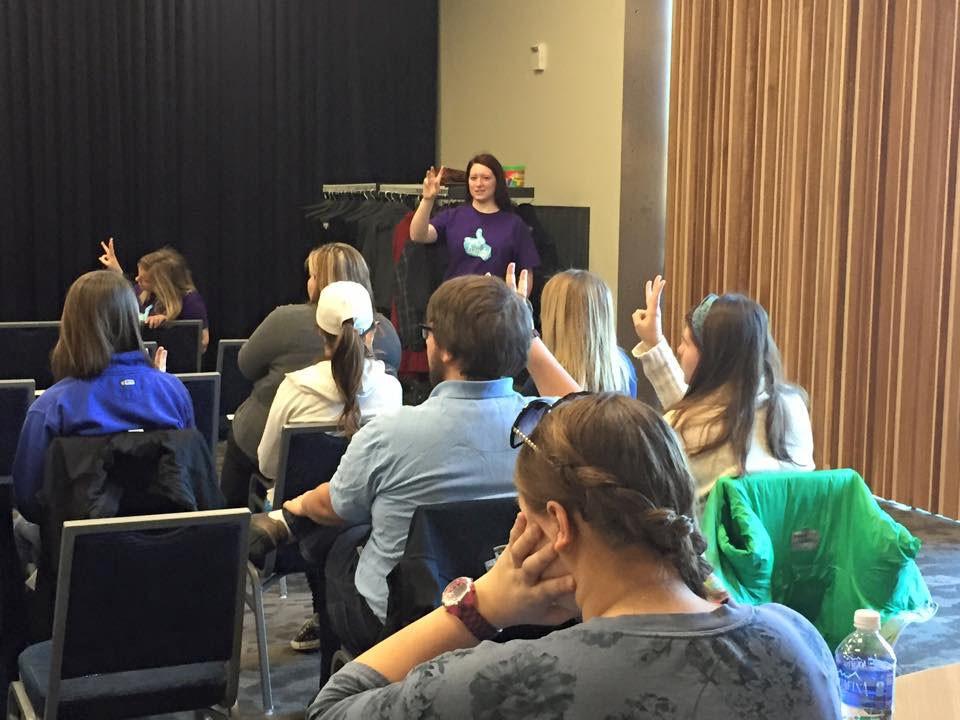Sign language club focuses on deaf culture

GVL / Courtesy – American Sign Language Club
Sep 17, 2015
When people think of being bilingual, they don’t immediately think of American Sign Language as a foreign language. According to the Modern Language Association, American Sign Language (ASL) is the third-most studied foreign language in U.S. colleges and universities.
Grand Valley State University’s American Sign Language and Culture club offers experience with using sign language and information about deaf culture.
“Our club’s purpose is a service and advocacy,” said Jackie Frey, club president. “It’s to teach about the deaf culture and community.”
Meetings, which take place every Thursday at 9 p.m. in Lake Ontario Hall Room 167, also include teaching and learning how to sign. Students do not need to have any previous sign language experience to join the club.
“It’s also to teach sign language,” Frey explained. “It’s grammar, and it’s rules we learn about because it’s mostly a cultural thing.”
In addition to the culture, they also talk about events, community outreach and play games.
“In the beginning, the meetings consist of the board splitting the members up into beginners and advanced groups,” club member Sierra Nakano said. “Later on, they teach us about deaf culture and we watch videos and shows about it, while also talking about controversial topics such as cochlear implants.”
Nakano, 20, has been a part of the ASL club since fall 2014. She initially joined the club because her sister piqued her interest by teaching her signs throughout high school.
“She taught me signs here and there, and it was always fun to practice with her,” Nakano said. “She has had so much experience with her job, schooling and being in the deaf community.”
The club learns words pertaining to current events or holidays such as ‘skeleton’ or ‘costume’ in October meetings or ‘Christmas’ and ‘menorah’ in December meetings. They also have an event called “silent dinners” where they agree on a restaurant to meet at and sign the whole time there; they don’t use their voices to communicate.
“My favorite part of the ASL club is the silent dinners,” Nakano said. “We try to make the staff at the restaurant believe we are deaf while practicing our signing.”
Learning a different language can be difficult, but it is outweighed by the benefits of being bilingual. It can improve mental and cultural awareness, and it can help increase understanding of the English language. The MLA reported that in 2013, American Sign Language had the second-highest percentage increase in enrollment since 2009.
“I think one of the benefits of learning sign language is that it opens up a new way of talking to people that perhaps you could not before,” Nakano said. “It’s a fun opportunity to open your mind and learn about another culture and language.”
Like English, ASL also has slang words that different parts of the country will say differently. Some people will sign soda instead of pop. Sometimes, different states have different signs for things as well. Nakano mentioned that in Oregon, there is a different sign for ‘chicken’ than what she was taught in Michigan.
There are more types of sign language than American. There is also Australian Sign Language, German Sign Language and Spanish Sign Language. GVSU’s club only teaches American Sign Language, but they strive to teach about the deaf community as a whole.
“The goal of Grand Valley’s American Sign Language and Culture club is to give people here at Grand Valley the opportunity to not only learn another language, but to allow them the chance to understand a physical characteristic they may not have before,” Nakano said. “The deaf culture is very interesting and there are aspects of it that I did not know before this club.”

























